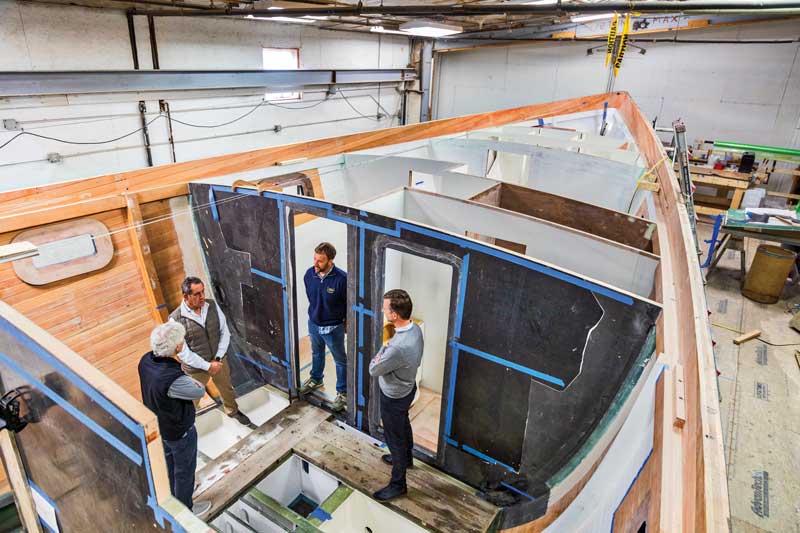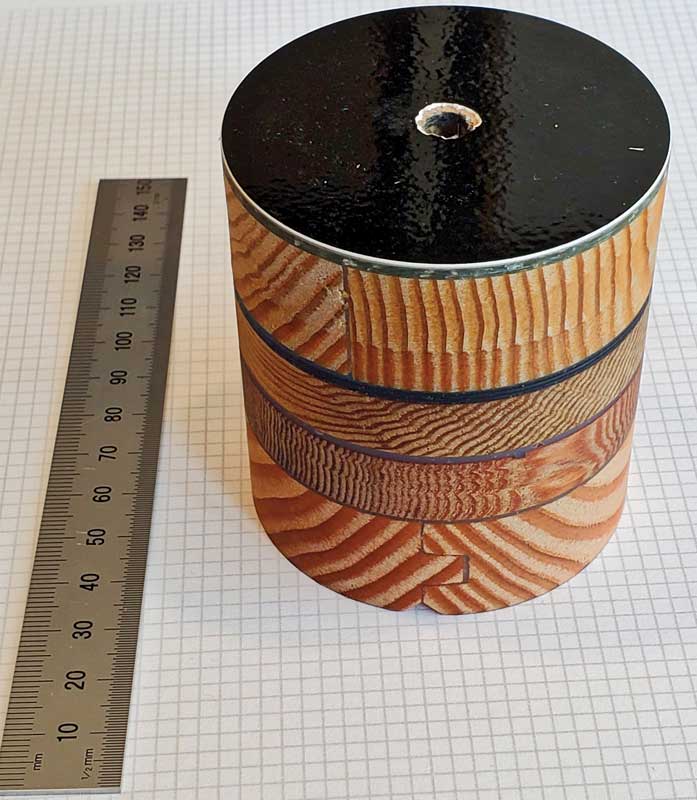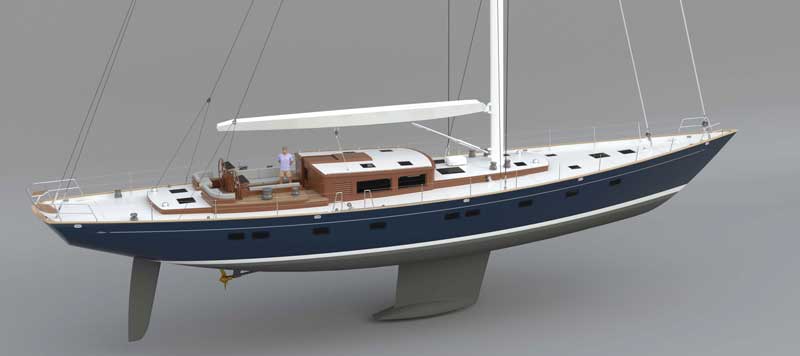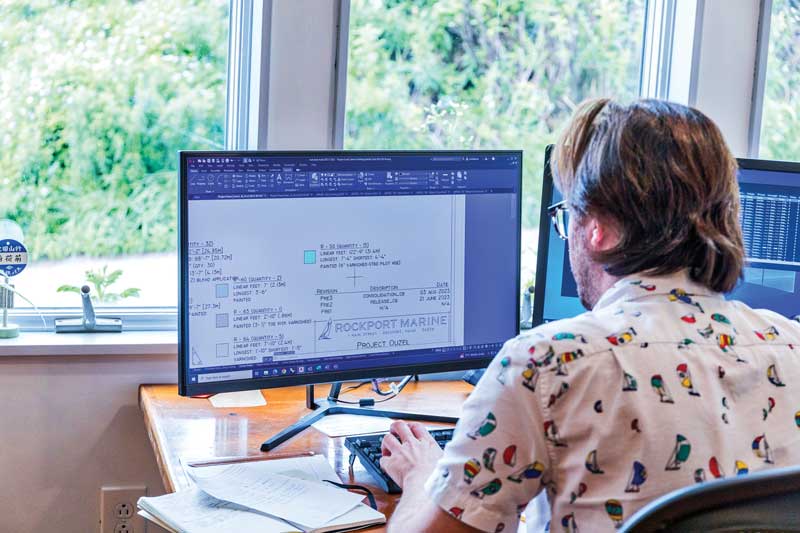Images courtesy Rockport Marine/Billy Black

Since it was founded in 1962 by Luke Allen, Rockport Marine has been known for taking on ambitious projects. Now, under the direction of third-generation boatbuilder Sam Temple, who took the helm from his step-father, Taylor Allen, in 2014, the yard is in the midst of a monumental new-build: a stunning 95-foot, wood composite pilothouse yacht to be named Ouzel.
The project is very much the marriage of traditional boatbuilding skills and materials with cutting-edge composite work and computer design. And, it is the largest vessel the company has ever built.
 A worker on the deck of the 95-footer provides a frame of reference as to Ouzel’s size. Project Ouzel came to Rockport Marine on a recommendation from Peter Wilson, founder of MCM Newport and the project manager/owner’s representative. “I’d worked with Peter on a previous project, a Bill Tripp 45 called Mist. Peter understood our capabilities and suggested us to the clients for the project. Langan Design Partners (Newport, Rhode Island) and Mark Whiteley Design of the United Kingdom round out the design/build team,” Temple said.
A worker on the deck of the 95-footer provides a frame of reference as to Ouzel’s size. Project Ouzel came to Rockport Marine on a recommendation from Peter Wilson, founder of MCM Newport and the project manager/owner’s representative. “I’d worked with Peter on a previous project, a Bill Tripp 45 called Mist. Peter understood our capabilities and suggested us to the clients for the project. Langan Design Partners (Newport, Rhode Island) and Mark Whiteley Design of the United Kingdom round out the design/build team,” Temple said.
The yacht is being built of cold-molded Douglas fir, western red cedar, and carbon-fiber cloth, all laid up over a male building jig. The yard is now 70 weeks into the construction contract with a projected delivery date in the fall of 2025.
“It was a challenge getting this big ball rolling,” Temple said. “I was determined not to dial back any of the yard’s regular storage and service work. We did have several large projects cross my desk that I felt I had to decline to accommodate Ouzel. I’ve got to admit, it’s been a novel experience for me to turn away work.”
 A core sample taken from the hull shows the orientation of wood grains and composite materials used in the boat’s layup. Photo by Ted HuggerTemple maintains that such large projects evolve over a long period of time. His team is used to building vessels in the 50-foot range. He said that for his crew, a 95-foot hull can be “a long slog” of planking and fairing. “One thing I did before committing to Ouzel was to ask the crew if they were up for it.”
A core sample taken from the hull shows the orientation of wood grains and composite materials used in the boat’s layup. Photo by Ted HuggerTemple maintains that such large projects evolve over a long period of time. His team is used to building vessels in the 50-foot range. He said that for his crew, a 95-foot hull can be “a long slog” of planking and fairing. “One thing I did before committing to Ouzel was to ask the crew if they were up for it.”
And they were. Still, Temple said, “At this scale, it takes a long time to glue up the hull, a long time to fair the boat, and a long time to install the systems and interior components. Some people just don’t like to work on wood-composite jobs of that scale,” Temple added. “As an employer, that’s important for me to hear—I need everyone here to be invested and enthusiastic about the projects they’re working on.”
In the end, most of Temple’s employees were excited about the new work. Others came to him who said they would prefer to work on the yard’s more traditional, plank-on-frame jobs. Fortunately, Rockport Marine has an abundance of both types of work to ensure his team is happy with their roles.

The logistics of fitting a 95-foot boat into the yard’s buildings and managing workflow was a considerable undertaking. “It involved planning our service fleet work to make sure that we could accomplish those customer’s needs out of just two work bays,” he said.
Temple rebuilt the upper mezzanine of the main shop to allow more boat-level workspace for Project Ouzel, and he made a significant investment in new tooling—vacuum tables and fabrication equipment. The massive hull and deck are being built side-by-side.
Ouzel is designed to be a world-cruising vessel, typically carrying relatively small parties aboard; the boat is designed with accommodations for two to four crew and two to six in the owners’ party. “Our clients are experienced and knowledgeable sailors,” Temple noted. “Performance is important, and this will be a vessel that sails exceptionally well, but you won’t be seeing her on the racing circuit.”
Still, managing weight has been an important part of this project. “Just because we’re not trying to make the boat ultralight doesn’t mean that we’re not very deliberate about what it does weigh, and where that weight goes, allowing the designers to make accurate predictions and design accommodations,” Temple said.
For example, Ouzel’s midships tankage is part of a composite structural grid that will transmit the keel loads into the hull for maximum strength with minimum weight. “It makes for a better boat with superior allocation of strength and space,” Temple explained.
“The boat has a powerful rig, and about a third of the boat’s displacement is in the ballast. With a draft of 12 feet, Ouzel will sail terrifically,” Temple said.
 The company has hired 10 people since taking on Project Ouzel, an 18-percent increase, across all disciplines, including carpenters, system technicians, painters, and fabricators. Investments were also made in employee training, focusing on composites procedures.
The company has hired 10 people since taking on Project Ouzel, an 18-percent increase, across all disciplines, including carpenters, system technicians, painters, and fabricators. Investments were also made in employee training, focusing on composites procedures.
Case in point, Aaron Johnson, the company’s paint foreman with 20 years of experience, was interested in changing his career trajectory. Johnson decided he would like to work with composites. “I was going to sub-contract some components to Steve Hassett whose Custom Composites Technology company is based in Bath,” Temple said. “There was an opportunity to contribute some of our labor to accelerate building the parts and gain some education. Aaron volunteered to make the commute to Bath for 10 weeks of intensive composite training by Hassett and his crew. Today, Aaron is now one of our composite specialists. It was a unique collaboration that benefited all parties,” he added.
Temple also developed a unique blending of roles that’s driving both efficiency and innovation. Two Rockport Marine builders, Ben Diamond and David Kelly, have become proficient at 3-D computer modelling. Once they’ve modelled a project, they then move onto the shop floor to build the components they’ve modeled.
“There are areas of this boat that are very complex,” Temple continued, “small areas with a lot of detail, such as Ouzel’s forepeak.” The forepeak includes several deck hatches; below them is a platform housing the windlass and chain bin. A lot of systems enter the forepeak. Ergonomics are important; a crew member has to be able to climb down a ladder into the space safely and efficiently.
 Diamond has 3-D modeled this complex area and has been able to tweak and adjust the layout of the forepeak to improve its functionality. “Three-dimensional modeling will go a long way in designing such spaces, but there’s no substitute for executing the design of these spaces firsthand. Ben can fine-tune and adjust the layout of the space as he builds,” Temple said.
Diamond has 3-D modeled this complex area and has been able to tweak and adjust the layout of the forepeak to improve its functionality. “Three-dimensional modeling will go a long way in designing such spaces, but there’s no substitute for executing the design of these spaces firsthand. Ben can fine-tune and adjust the layout of the space as he builds,” Temple said.
Kelly has computer modelled a dropping, counterweighted, vertical companionway door. He is now building a full-size physical mock-up of the door and its components. “From the mock-up, Dave will refine his computer drawings including all the plumbing and electrical runs under and around the door to ensure the accessibility and function of these components. Finally, he will build the part,” Temple said.
So rather than a number of people each working in individual silos (plumbing, electrical, hydraulics, carpentry, etc.), the shop has one individual with a deep understanding of the project. They are able to address issues during the 3-D modeling and mock-up process; the result is much greater manufacturing productivity, according to Temple.
He says that the benefit from this design/build role is greater efficiency, less opportunity for miscommunication between departments, identifying potential problems and solutions before construction begins, and minimizing re-work.
Now in its seventh decade and under Temple’s vision, Rockport Marine is poised to serve the midcoast fleet of yesterday and tomorrow.
✮
Ted Hugger lives in Damariscotta, Maine, with his wife, their cardigan Welsh Corgi, and their 55-year old wooden trawler.






